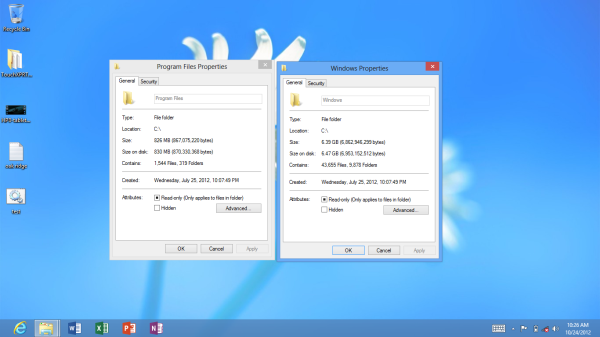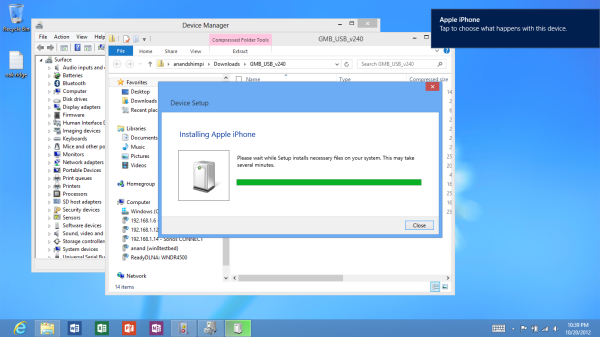The Windows RT Review
by Vivek Gowri & Anand Lal Shimpi on October 25, 2012 12:00 PM EST- Posted in
- Windows RT
- Operating Systems
- Microsoft
- Mobile
- Windows 8
- Tablets
UI Performance, Storage, and USB Compatibility
by Vivek Gowri and Anand Shimpi
With Windows Phone 7, Microsoft did a great job of taking generation-old hardware and delivering a great user experience in spite of any silicon-level deficiencies. So naturally, with the new Windows UI, we were expecting a very smooth UI regardless of the underlying hardware. And they’ve most certainly delivered on that.
Animation frame rates are consistently good all the way through the UI, easily delivering what appears to be 60 fps for UI transitions. When pushed, Modern UI seems more likely to completely drop animations versus dropping frames, which eliminates the choppy experience you sometimes find in Android. It isn’t a common occurrence, the experience is generally very fluid. This kind of consistently smooth UI is what Google has been striving for in every recent release of Android, dedicating the release of 4.1 to eliminate the dropping of frames in even basic interactions. Scrolling, swiping, snapping, app switching - it doesn’t really matter what you’re doing, RT is just really smooth. Combined with the fluidity of the gestures, the entire system just feels like liquid, there are just no real slowdowns even running on a no-longer impressive SoC like Tegra 3.
| Application Launch Time Comparison | |||||||
| Boot | Web Browser | Maps | Games Center / Xbox | ||||
| Apple iPad (3rd gen) | 32.0s | 1.0s | 2.4s | 1.1s | 1.9s | ||
| Microsoft Surface | 27.7s | 2.6s | 7.1s | 5.0s | 5.0s | ||
But there is one area that RT struggles in, and it’s something that was an issue in Windows Phone 7 too - application launch times. Anand included this table in his Surface review, and it shows that boot performance is decent, but the 3rd generation iPad just kills it in application loading. The new A6X-infused 4th gen iPad probably widens that gap too, so it’s a pretty stark difference. It’s something that Microsoft needs to really focus on when updating the OS, because it’s easily one of the most glaring flaws in an otherwise stellar interface.
From a storage standpoint, the OS takes up between 6.5 and 7.5GB of space (Anand measured 6.47GB on Surface, I measured 7.35GB on the VivoTab RT) and Office takes up another 750-850MB (830MB for Surface, 749MB for the ASUS), so you’re looking at 7.5-8GB of NAND dedicated to the OS. On my 32GB VivoTab RT, I had 25.3GB of storage to start with, so after Windows and Office, I was looking at 17GB left over for programs and documents. That’s....not a lot - a bit of music, a decent selection of applications, a couple of videos, and pretty soon I’m looking at less than 10GB of storage left over. Thankfully, we’re seeing microSD slots on a lot of the more prominent Windows RT slates, so if you run out of room, you could theoretically toss in a 32GB or 64GB microSDXC card. Depending on how much data you plan on storing, I think you can get away with the lesser internal NAND and some microSD cards.
It’s also pretty clear that there will not be a Windows RT slate shipped with less than 32GB of onboard NAND. If you’re holding out for a cheaper Windows RT device with less storage, like a 16GB tablet for $399, there’s almost no way that happens - it’s implausible to think that anyone would ship a tablet with less than 5GB of space left for data storage.
Another key detail in Windows RT is wide-ranging USB peripheral support. USB ports have been a common feature on 10” Android tablets, but device support was typically limited to flash drives and basic input devices. The goal with Windows RT was to bring the traditional Windows experience to tablets, so USB driver support is pretty important. It’s not as easy as on an x86 system, where most USB peripherals would just work, but even with more limited Windows-on-ARM drivers, it’s pretty decent overall.
USB drives obviously work as you’d expect them to. Even SATA to USB adapters worked fine when plugged into Surface. Other smartphones and tablets also worked, although their level of support varied. For example, you can plug in the iPhone 5 and have it come up as a supported device for moving pictures to/from. However USB tethering is not supported by the class driver included in Windows RT. You can even plug an iPad into Surface and get the same level of support. The few Android phones I tried to connect in MTP all worked as expected, though transfer rates off my Optimus 4X HD seemed on the slow side, likely a function of the phone’s internal eMMC.
Printer support is pretty decent, although the Epson Workforce 910 Anand tried didn’t actually have specific driver support under RT. Although development for the desktop side of Windows is limited, manufacturers can supply Windows RT drivers to enable support for some more obscure devices. Unfortunately when it comes to those devices you’ll have to play the waiting game as there’s simply not a lot of third party Windows RT drivers available for download today.












233 Comments
View All Comments
aepxc - Thursday, October 25, 2012 - link
..."Tablets (despite being low power) are cannibalizing the PC market. Why is this?"...IMHO, because number of activities that can be done with a computer >> number of activities that can be done on a computer. I really think the consumption vs. creation framing is a misunderstanding – the thing actually being measured is how much of the creation is done on the computer (e.g. read an interesting article, form a new insight into a problem you have been trying to solve), and that is not, I believe, of significant importance.
But thanks for your response – it's an interesting perspective, well-argued.
ludikraut - Friday, October 26, 2012 - link
..."Tablets (despite being low power) are cannibalizing the PC market. Why is this?"...I'm not sure that tablets are cannibalizing PC sales. I think instead PC sales have remained stale as for several years now the hardware has been powerful enough for the average user to do just about anything they need on their computer. This means that instead of buying a new PC every two to three years, you've now got that money available to purchase something in addition to your existing and perfectly capable PC. More times than not that extra purchase will take the form of a tablet or e-reader these days, IMO. So in essence I think overpowered PCs are helping to drive tablet sales. :)
l8r)
twtech - Saturday, October 27, 2012 - link
I would tend to agree with that. I think they will have some impact on PC sales in the cases where the PC would have been bought solely for somebody to browse Facebook with.I have no interest in giving up my PC though, even as I type this post out on a Nexus 7. I use this thing mostly for web browsing and watching Netflix when I don't want to have to sit at a desk. My desktop PC does everything else.
steven75 - Friday, November 2, 2012 - link
The iPad has had a first party office suite since the first iPad was announced in 2010, along with third party word processors too numerous to count.What exactly is stopping you from taking notes in class on an iPad? Can't find a BT hardware keyboard out of the hundreds available?
I don't get this argument. At. All.
daboochmeister - Thursday, October 25, 2012 - link
You didn't point out that there are real limitations with the Office included in the Surface RT ... no macros/plug-ins, and you can't use it for any work-related tasks unless there's a separate license for Office 13 in place.http://office.microsoft.com/en-gb/home-and-student...
Notice that last comment - many reviewers are glossing over this - you need a license for Office 13, not a previous version, to use it for work tasks. If your company hasn't upgraded, you can't (legally) use it for anything for-profit.
Spivonious - Thursday, October 25, 2012 - link
Just like every version of Office Home and Student from 2007 on. This is not specific to Office 2013 on Windows RT.daboochmeister - Thursday, October 25, 2012 - link
But it has particular relevance here, because of the way the Surface RT has been viewed (and reviewed) as a business tablet ... but there's been little discussion of these limitations.For example, I haven't seen a single review point out that if your company has only licensed Office 2010, you don't have the necessary license to permit (legal) use. Do you, Spivonious? Has your company upgraded? Mine hasn't ... and our customer sites still use 2003, many of them.
And ... a key difference is that most business licenses permitted installation of the full suite on people's PCs at home -- eliminating the concern about macros/plug-ins/forms/3rd party apps. That's simply not possible here.
ssiu - Thursday, October 25, 2012 - link
Yeah the bundled Office RT gives no extra value for companies. That is because it is a "Home and Student" version. But that is no different than the "traditional x86 Office Home and Student" license -- you cannot use that for work either (even non-profit organizations), even if you buy it.(Whether people follow or ignore the license restriction is a separate issue ...)
daboochmeister - Thursday, October 25, 2012 - link
See my reply above for why there is a big difference in this case ... most business licenses permitted an employee to install a copy on a home PC, for business use. That simply won't be possible here.karasaj - Thursday, October 25, 2012 - link
Most businesses will probably go for Windows 8 or Windows 8 Pro (See Surface Pro). RT really honestly has simply been marketed for exactly that - home and student use.